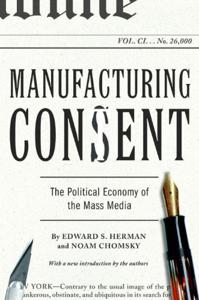
Want to learn the ideas in Manufacturing Consent better than ever? Read the world’s #1 book summary of Manufacturing Consent by Edward S. Herman here.
Read a brief 1-Page Summary or watch video summaries curated by our expert team. Note: this book guide is not affiliated with or endorsed by the publisher or author, and we always encourage you to purchase and read the full book.
Video Summaries of Manufacturing Consent
We’ve scoured the Internet for the very best videos on Manufacturing Consent, from high-quality videos summaries to interviews or commentary by Edward S. Herman.
1-Page Summary of Manufacturing Consent
Overview
The media has many roles, including informing us, entertaining us and amusing us. However, it also has an additional important task—promoting shared social values and codes of behavior to the general population. The government uses the mass media to spread its ideals and code of behavior to the public at large.
The media defends the interests of those in power. They do this by supporting the status quo, which is made up of a small group of people who control society’s wealth and power. The media therefore slants their coverage to support these powerful groups.
The media often claim that they are there to hold the powerful accountable, but in reality, they protect the interests of those who have power and influence. They use a biased lens to report events so that people accept their position in society as inferior.
Media helps to shape the opinions of people and create a certain mindset.
Big Idea #1: The media will never criticize the ruling elite, but may appear to do so when opinions within the elite are divided.
In some cases, the media criticize politicians and business leaders. These people are sometimes criticized for bad things they’ve done. For example, Watergate was a scandal that involved breaking the law and criticizing Nixon by investigating him more closely than before.
The idea that the media is biased toward the wealthy and powerful seems to be disproved by recent events. The media is quick to criticize those in power, but when it comes down to criticizing people outside of power, they ignore them or suppress their criticisms.
The Watergate scandal was a prime example of this. The media were more than willing to investigate and pursue Richard Nixon and his accomplices, because the victims of their crime were the powerful Democrats, who are part of the elite class. When it came to investigating illegal spying on an innocent party by government agencies, they remained silent.
The media will never criticize the ruling class, but it may appear to do so when there are disagreements within that group.
Big Idea #2: The mass media follow a ‘propaganda model’ that filters out information counter to elite interests.
The mass media focuses on the interests of those in power. They ignore stories that challenge their views and suppress them if they can’t ignore them.
Unlike media in authoritarian countries, the western media is not controlled by the government. Instead, it’s influenced by societal pressures and a few other factors that make it difficult to be truly objective. The main factors are described in a model called “propaganda.” It contains various filters through which information must pass before becoming newsworthy.
Media outlets are often influenced by the financial interests of their owners and advertisers. For example, General Electric is a large company that owns many media outlets. They have an interest in nuclear power and weapons, so they make sure these areas don’t get much attention from their media networks.
Newspapers and other media tend to rely on sources for news. These sources could exert control over the media by providing them with carefully selected information that paints a certain picture of events.
The media are controlled by the elite, so they only present news that supports their interests.
Big Idea #3: Most of the mass media is owned by a few wealthy families and corporations whose main objective is profit.
In the early 19th century, Britain’s left-wing press was owned by small proprietors. The media helped represent working class views and threatened the ruling class’ monopoly on information. Despite attempts to quell this media through libel laws and prosecutions, it remained strong.






